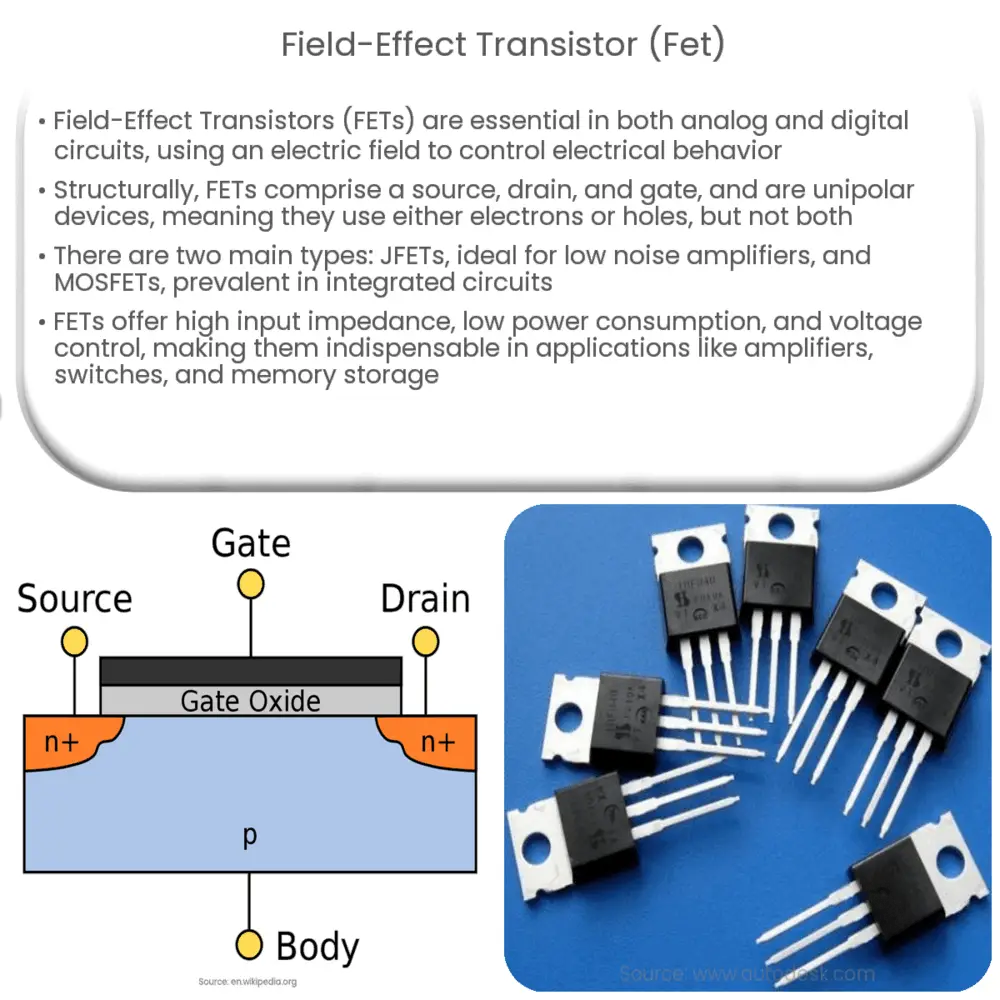Explore the basics of Field-Effect Transistors (FETs), their structure, types, operation, characteristics, and applications in electronic circuits.

Introduction to Field-Effect Transistors (FETs)
A Field-Effect Transistor (FET) is a type of transistor commonly used in both analog and digital circuits. It is distinguished from other types of transistors by its principle of operation, where the electric field effect is used to control the electrical behavior of the device.
The Structure of FETs
Generally, FETs consist of three regions: source, drain, and gate. The source is the region where current enters, the drain is where current leaves, and the gate is the control terminal. Notably, unlike in Bipolar Junction Transistors (BJTs), the current in FETs is carried by either electrons or holes, but not both. This is why they are referred to as unipolar devices.
- Source: This is the region where carriers (either electrons or holes) are injected into the device. The source is equivalent to the emitter in a BJT.
- Drain: This is the region where carriers leave the device, equivalent to the collector in a BJT.
- Gate: The gate is the control terminal. By applying a voltage to the gate, the current flow between the source and drain can be regulated.
Types of FETs
The two primary types of FETs are Junction FETs (JFETs) and Metal-Oxide-Semiconductor FETs (MOSFETs).
- JFETs: These are the simplest type of FET and are usually used in low noise amplifiers. The gate is formed by a p-n junction, hence the name Junction FET.
- MOSFETs: They are the most widely used type of FET, especially in integrated circuits. A MOSFET features a metal gate separated from the semiconductor by a thin layer of insulating material (typically silicon dioxide), hence the name Metal-Oxide-Semiconductor FET.
Operation of FETs
The operation of a FET is governed by the use of an electric field to control the electrical conductivity of a channel. This is accomplished by applying a voltage to the gate terminal, altering the distribution of charge carriers in the channel and modulating the current flowing between the source and drain.
When a suitable voltage is applied to the gate, it creates an electric field within the transistor. This field influences the charge carrier distribution, thereby controlling the current flow between the source and drain. The higher the voltage applied, the more the current is allowed to flow.
FET Characteristics
Field-effect transistors have several distinguishing characteristics. Here are some of the most notable:
- High Input Impedance: FETs have a very high input impedance (resistance), often in the megaohm range. This makes them ideal for use in many electronic devices and applications where minimal loading of the signal source is desired.
- Voltage Control: In a FET, the output current is controlled by an input voltage. This property is utilized in amplifiers and switching applications.
- Low Power Consumption: FETs, especially MOSFETs, have very low power consumption, making them suitable for use in battery-powered devices.
Applications of FETs
FETs are employed in a wide range of applications due to their unique characteristics. Some of the primary applications include:
- Amplifiers: Due to their high input impedance and low power consumption, FETs are commonly used in amplifier circuits.
- Switches: FETs, especially MOSFETs, are extensively used in digital circuits as electronic switches.
- Buffers: FETs are used in voltage buffer applications due to their high input impedance and low output impedance.
- Charge Storage: The MOS capacitor structure in MOSFETs allows them to store charge, making them useful in dynamic random-access memory (DRAM) cells.
Conclusion
In conclusion, Field-Effect Transistors (FETs) play a vital role in the field of electronics. Their unique properties, such as high input impedance, low power consumption, and voltage control, make them invaluable in a vast array of applications ranging from amplification to digital switching. The two main types of FETs, JFETs and MOSFETs, each offer specific advantages that engineers can leverage depending on the requirements of the circuit. As technology continues to evolve, it’s certain that the significance of FETs in electronic design will remain paramount.

